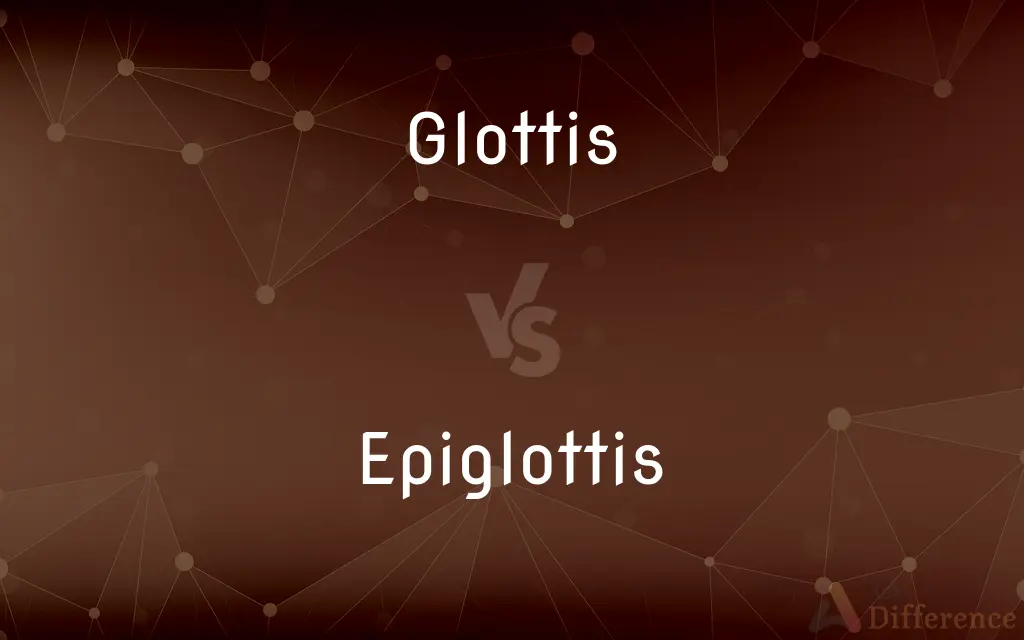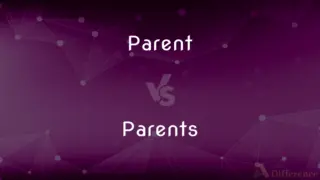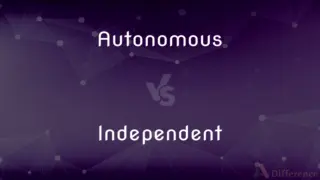Glottis vs. Epiglottis — What's the Difference?
By Tayyaba Rehman — Updated on September 22, 2023
The "glottis" is the opening between the vocal cords, while the "epiglottis" is a flap that covers the glottis during swallowing to prevent food from entering the windpipe.

Difference Between Glottis and Epiglottis
Table of Contents
ADVERTISEMENT
Key Differences
Within the intricate structure of the human throat, the "glottis" and "epiglottis" serve vital but distinct functions. The glottis refers to the opening between the vocal cords in the larynx, playing a pivotal role in voice production. When air passes through the glottis, it causes the vocal cords to vibrate, thus producing sound.
Conversely, the epiglottis is a leaf-shaped flap situated just above the glottis and is made of elastic cartilage. Its primary purpose is protective. When swallowing, the epiglottis acts as a shield, covering the glottis to ensure that food or liquids don't enter the trachea, which could lead to choking.
Interestingly, while the glottis is instrumental in modulating voice by adjusting the space between the vocal cords, the epiglottis remains mostly passive, springing into action primarily during the act of swallowing. It's essential to understand that the epiglottis's covering of the glottis is a swift and reflexive action, ensuring seamless and safe swallowing.
Further, it's fascinating how these two structures, the glottis and epiglottis, though closely positioned, carry out different roles so effectively. One aids in our ability to communicate through speech, and the other in safely navigating the path of ingested substances.
Comparison Chart
Location
Between the vocal cords
Above the glottis
ADVERTISEMENT
Function
Voice production
Prevents food and liquids from entering the trachea
Composition
Opening in the larynx
Elastic cartilage flap
Activity
Modulates voice by adjusting space
Reflexively covers the glottis during swallowing
Relation to Swallowing
Affected by the epiglottis covering
Directly covers the glottis
Compare with Definitions
Glottis
Part of the larynx involved in voice modulation.
The glottis adjusts its size to change pitch.
Epiglottis
Flap covering the glottis during swallowing.
The epiglottis prevents choking by shielding the windpipe.
Glottis
Opening between the vocal cords.
Sound is produced when air passes through the glottis.
Epiglottis
Leaf-shaped cartilage above the glottis.
The epiglottis stands guard over the entrance to the trachea.
Glottis
Area involved in breathing and speaking.
Breathing changes when the glottis is constricted.
Epiglottis
Part of the larynx ensuring safe ingestion.
Thanks to the epiglottis, food travels to the esophagus, not the lungs.
Glottis
Space where vocal cord vibrations occur.
The glottis widens or narrows, affecting voice quality.
Epiglottis
Protective structure in the throat.
The epiglottis acts swiftly when swallowing occurs.
Glottis
Central part of the voice box.
The glottis is crucial for vocalization.
Epiglottis
Reflexive shield during swallowing.
The epiglottis automatically covers the glottis when we swallow.
Glottis
The glottis is the opening between the vocal folds (the rima glottidis). The glottis is crucial in producing vowels and voiced consonants.
Epiglottis
The epiglottis is a leaf-shaped flap in the throat that prevents food from entering the windpipe and the lungs. It stays open during breathing, allowing air into the larynx.
Glottis
The part of the larynx consisting of the vocal cords and the opening between them. It affects voice modulation through expansion or contraction.
Epiglottis
A flap of cartilage behind the root of the tongue, which is depressed during swallowing to cover the opening of the windpipe.
Glottis
The opening between the vocal cords at the upper part of the larynx.
Epiglottis
The thin elastic cartilaginous structure located at the root of the tongue that folds over the glottis to prevent food and liquid from entering the trachea during the act of swallowing.
Glottis
The vocal apparatus of the larynx.
Epiglottis
(anatomy) A cartilaginous organ in the throat of terrestrial vertebrates covering the glottis when swallowing to prevent food and liquid from entering the trachea, and in Homo sapiens also a speech organ.
Glottis
(anatomy) The opening between the true vocal cords which is located in the larynx and affects voice modulation through expansion or contraction.
Epiglottis
A cartilaginous lidlike appendage which closes the glottis while food or drink is passing while food or drink is passing through the pharynx.
Glottis
The opening from the pharynx into the larynx or into the trachea. See Larynx.
Epiglottis
A flap of cartilage that covers the windpipe while swallowing
Glottis
The vocal apparatus of the larynx; the true vocal folds and the space between them where the voice tone is generated
Common Curiosities
Are the glottis and epiglottis directly connected?
They are closely positioned, with the epiglottis covering the glottis during swallowing.
What is the primary function of the glottis?
The glottis primarily functions in voice production.
Why is the epiglottis crucial during swallowing?
The epiglottis prevents food and liquids from entering the trachea, preventing choking.
Can problems with the epiglottis lead to choking?
Yes, if the epiglottis doesn't function correctly, it can lead to choking.
What produces our voice pitch?
Voice pitch is influenced by the size and tension of the glottis and vocal cords.
Can the size of the glottis change?
Yes, the glottis can widen or narrow, affecting voice pitch and quality.
How does the epiglottis respond to reflexes?
The epiglottis reflexively covers the glottis during swallowing.
Where is the epiglottis located?
The epiglottis is located just above the glottis.
Is the epiglottis always covering the glottis?
No, the epiglottis only covers the glottis reflexively during swallowing.
Does the glottis play a role in breathing?
Yes, the glottis is involved in both breathing and speaking.
How do the glottis and epiglottis interact?
The epiglottis covers the glottis during swallowing to protect the windpipe.
Are there surgeries related to the glottis and epiglottis?
Yes, surgeries can address issues or injuries related to these structures.
Are there medical conditions associated with the epiglottis?
Yes, conditions like epiglottitis, an inflammation of the epiglottis, can be serious.
Is the epiglottis a bone or cartilage?
The epiglottis is made of elastic cartilage.
Can injury to the glottis affect one's voice?
Yes, injury to the glottis can impact voice quality and production.
Share Your Discovery

Previous Comparison
Parent vs. Parents
Next Comparison
Autonomous vs. IndependentAuthor Spotlight
Written by
Tayyaba RehmanTayyaba Rehman is a distinguished writer, currently serving as a primary contributor to askdifference.com. As a researcher in semantics and etymology, Tayyaba's passion for the complexity of languages and their distinctions has found a perfect home on the platform. Tayyaba delves into the intricacies of language, distinguishing between commonly confused words and phrases, thereby providing clarity for readers worldwide.














































